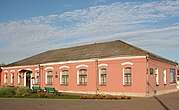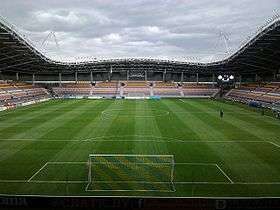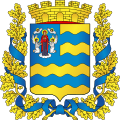Barysaw
Barysaw (also Borisov; officially transliterated as Barysaŭ,[2] Belarusian: Бары́саў [baˈrɨsaw]; Russian: Бори́сов [bɐˈrʲisəf], Polish: Borysów) is a city in Belarus situated near the Berezina River in the Minsk Region. With a population of around 145,000, it lies around 74 km northeast of Minsk.
Barysaw Барысаў (in Belarusian) Борисов (in Russian) | |
|---|---|
City | |
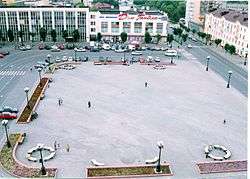 Central Square in Barysaw | |
 Flag  Coat of arms | |
 Barysaw Location of Barysaw | |
| Coordinates: 54°14′N 28°30′E | |
| Country | |
| Voblast | Minsk Voblast |
| Raion | Barysaw Raion |
| Founded | 1102 |
| Area | |
| • City | 45.97 km2 (17.75 sq mi) |
| Elevation | 169 m (554 ft) |
| Population (2013) | |
| • Estimate (2015) | 144,945[1] |
| • Urban | 180,100 |
| Time zone | FET (UTC+3) |
| Postal code | 222xxx |
| Area code(s) | +375 01777 |
| License plate | 5 |
| Website | Official website |
History
Middle Ages and early modern era
.jpg)
Barysaw is first mentioned in the Laurentian Codex as being founded (as Borisov) in 1102 by the Polotsk prince Rogvolod Vseslavich, who had the baptismal name of Boris (the name of the city literally means Boris'). During the next couple of centuries it was burned and then rebuilt slightly south of its original location.
At the end of the 13th century it became a part of the Grand Duchy of Lithuania, after the Union of Krewo (1385) part of the Polish–Lithuanian Union. In 1500 during the Lithuanian–Muscovite War, Alexander Jagiellon resided in Barysaw Castle. In 1563 it was granted Magdeburg town rights by King Sigismund II Augustus. In 1569 (after the Union of Lublin) it became part of the Polish–Lithuanian Commonwealth, and then became part of the Russian Empire in 1793 as a result of the Second Partition of Poland. In the last years of the Polish-Lithuanian Commonwealth, troops were stationed here, including the 4th Advance Guard Regiment, and King Stanislaw August established the town's coat of arms (decree #17435), the top half containing the coat of arms of Minsk, while the lower half had two stylized towers on a silver background with a passage between them and Saint Peter above the towers holding a key in his hand.
19th century
.jpg)
After the Partitions of Poland, Barysaw was an uyezd town located in the Minsk Governorate.
In 1812, Barysaw became a crucial location when Napoleon's troops crossed the Berezina river. The French feinted a crossing at the town itself, but successfully escaped the pursuing armies by building two wooden bridges north of the city, at Studianka. This event is reenacted by military locals during town festivals. A cannon from the Napoleonic era is kept by the town's museum.
In 1871, the railway between Brest and Moscow passed near Barysaw, and a station was built there. In 1900 the area around the station was annexed the town.
20th century
_(2).jpg)
During World War I, after the fall of tsarist Russia, fights broke out for control of the city and it changed owners several times. In November 1917 the area became a part of Soviet Russia, from early 1918 it was occupied by Germany, in December 1918 it fell to the Soviets again, from 1919 to 1920 it was controlled by Poland, before being captured by the Soviets for the third time. Soviet rule was recognized by the Peace of Riga in 1921 and the city was included in the Belarusian Soviet Socialist Republic.
_(2).jpg)
During World War II, Barysaw was occupied by Nazi Germany from 2 July 1941 to 1 July 1944, and most of the city was destroyed. More than 33,000 people were killed in six death camps which were constructed around the town.
Since May 1948 the city has been home to the headquarters of the 7th Tank Army, which became the 65th Army Corps and then the North Western Operational Command of the Armed Forces of Belarus in 2001. In 2000s the Head of City Administration, or Mayor, was Vassily Burgun.[3]
Industry
After World War II Barysaw became a major industrial centre, and as of 2002 there are 41 large factories, whose goods are exported to Russia, the CIS, and abroad. The railroad is still an important artery, but now it is powered by overhead electric lines.
The following industries are prominent in town: Borisov Plant of Motor-and-Tractor Electric Machinery, Borisov Plant Avtogydrousilitel, Borisov Aggregate Works, the Ekran Company, Dzerzhynski Crystal Works, Borisov Plastics Plant, the 140th Repair Works, the 2566th Plant on Radioelectronics Equipment Maintenance, the Rezinotekhnika Company, Borisov Meat Packing Plant, Borisov Plant of Polymer Package Polimiz, the Belarusian-German joint venture Frebor, the Lesokhimik Company, the Metallist Company, the Paper Factory of the state emblem department under the Finance Ministry of the Republic of Belarus, the Borisovdrev Company, the Borisovkhlebprom Company, Borisov Bakery, Borisov Sewing Factory, the Shveinik Company, Kischenko Crafts Factory, Borisov Dairy, Borisov Tinned Plant, others. The total industrial staff reaches 31,019 people.[4]
The largest factories, in no particular order, are:
- BATE (electricity automobile parts)
- AGU (avto-gidro-usilitel — power steering in Russian)
- Pharmaceutical plant (medpreparatov)
- Turbocompressors plant (agregatov)
- Match factory (Borisovdrev)
- BoriMak (factory producing pasta, spaghetti)
- Zdravushka (Dairy products)
- Rezinotechnika (Rubber factory)
- Meat processing factory
- DOC (Wood products manufactury)
Modern living
The town is divided by the river into old and new parts connected by two bridges. The railway station, international road, Ispolkom (ex-KPSS Gorispolkom), military staff headquarters and the central square are in the new part. As usual for this region, families live mostly in flats in large, modern apartment buildings, but there are some single-family homes on the outskirts, some of which do not yet have indoor plumbing. The water comes from an artesian well and is very clean and healthy.
Authorities
Sport
Main sport sites: 2 stadiums, 3 swimming pools, 14 shooting galleries, 8 sportsgrounds
The football team BATE Borisov are based in the city. They have won the Belarusian Premier League 15 times, and competed in the UEFA Cup and UEFA Champions League. There is also a famous basketball team Berezina-RCOR. European basketball championship for women (division B) was organized in Barysaw.
Media
Notable residents
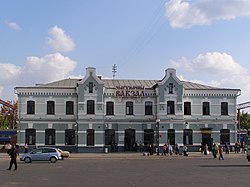
- Anatoly Andreyevich Gromyko, (1932–2017), Soviet and Russian scientist and diplomat.
- Anatoly Chubais, (born 1955), Soviet and Russian economist
- Haim Laskov, (1919-1982), the fifth Chief of Staff of the Israel Defense Forces
- Andrei Aramnau, (born 1988), weightlifter and world record holder
- Dzmitry Baha, (born 1990), footballer
International relations
Twin towns — sister cities
Barysaw is twinned with:
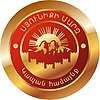

.png)
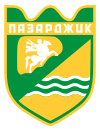
.svg.png)
References
- Численность населения на 1 января 2015 г. и среднегодовая численность населения за 2014 год по Республике Беларусь в разрезе областей, районов, городов, поселков городского типа [Population as of 1 January 2015 and 2014 year-average population in regions, raions, towns of Republic of Belarus] (in Russian). Archived from the original on 2015-05-15.
- "Report on the current status of United Nations Romanization Systems for geographical names compiled by the UNGEGN Working Group on Romanization Systems Version 4.0: Belarusian". Institute of the Estonian Language. February 2013. Retrieved 16 January 2016.
- В Борисове составлен свой список невъездных чиновников [Its own list of members of authorities who are not eligible to leave the country was created in Barysaw] (in Russian). Правозащитный центр «Весна».
- "Industry - Economy - Borisov Region/Borisov/Borisov News/Borisov Region News/Borisov Regional Executive Committee". www.borisov.minsk-region.by. Archived from the original on 2018-09-08. Retrieved 2012-04-30.
- Назначение [appointment] (in Russian). Борисовский райисполком. 10 January 2009. Archived from the original on 3 October 2017. Retrieved 13 June 2015.
- "Борисовские новости" — в новый год с новыми проблемами ["Borisovskiye Novosti" - entering new year with new problems] (in Russian). Archived from the original on 7 April 2009.
- Телерадиокомпания "СкиФ" [Teleradiocompany "Skif"] (in Russian).
External links
| Wikimedia Commons has media related to Barysaw. |
.jpg)

